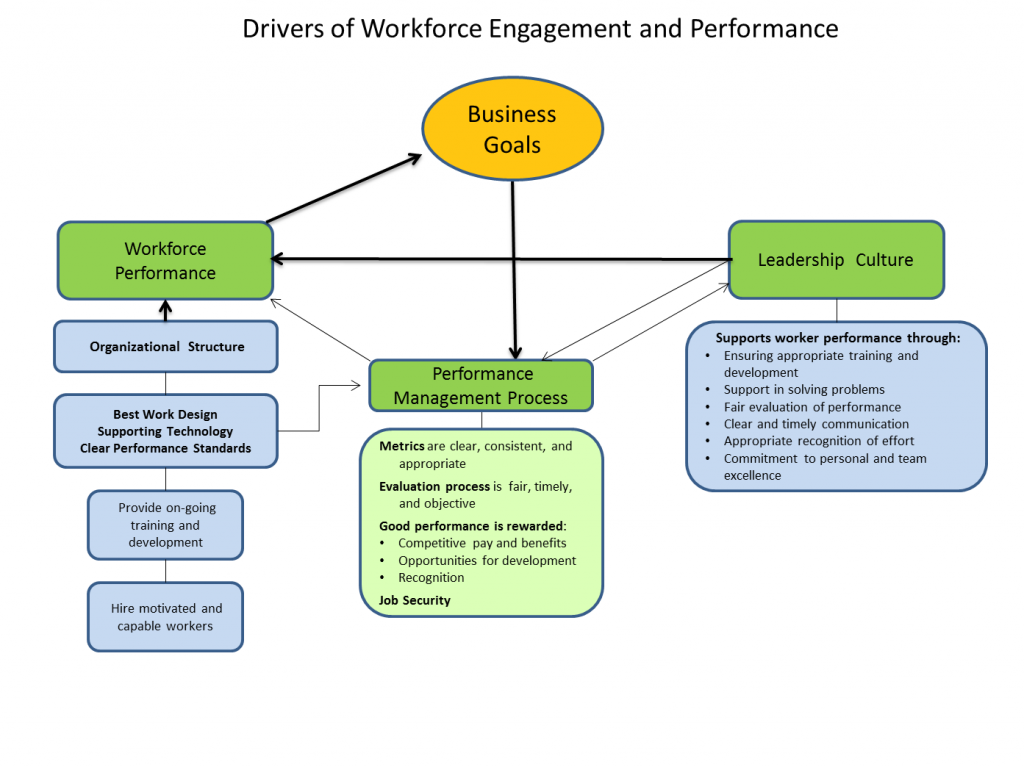Revitalizing and Improving Employee Engagement
Engaged employees are committed to accomplishing the company’s work and enthusiastically believe they play an important part in achieving its goals. Multiple studies have demonstrated that disparities in employee engagement account for 35 to 50 percent of the variance in workforce productivity and customer satisfaction. High employee engagement has been shown to have a similar positive effect on reducing the rates of safety incidents and turnover, both of which are costly. Clearly, the advantages of maintaining an engaged workforce can translate into millions of dollars to a company’s bottom line.
Many companies have invested significant amounts of money and effort in developing performance measures and management strategies, only to find that their execution does not result in the desired improvements in customer satisfaction, productivity, or market share.
Often these strategic decisions are made without taking the needs of the workforce into full consideration. Performance deficits may develop as a consequence of employee reactions to changes in organizational structure, technology, work processes, or as the result of financial decisions that affect the workforce in unanticipated ways. Strategic decisions, or even incremental shifts, that were intended to improve performance at one point in time, may later result in workers disconnecting from their sense of commitment and satisfaction in their jobs.
Applying Our Workforce Analytics
Our approach to Workplace Analytics can make a significant difference. We recognize that there are multiple drivers behind the complicated exchange between a company and its workforce and no one factor holds the key. We help companies suffering from flagging performance take a comprehensive analytic approach that explores employee experiences and attitudes toward the work design, the performance management process, the reward structure, and the management culture.

We guide you.
Using our proven approach to Workplace Analytics, we help you ask the right questions. That ensures that you pursue relevant, reliable data from operations, finance, and HR to provide hard numbers on performance, pay, turnover, and absenteeism by individuals, teams, business units, and geographic locations.
Equally important, through focus groups and surveys we help you collect information on employee behaviors and attitudes related to specific drivers of engagement. To ensure meaningful data, we design surveys that are specifically tailored to reflect the vernacular of your workplace and depict the experiences and events particular to your company.
Identifying the interactions among factors that inhibit engagement not only makes the areas for intervention evident, but clarifies the particular changes necessary to improve performance.
We pursue answers
- What aspects of work and technology help or impede productivity? Survey data about the organization, work design, and technology will identify barriers.
- What key behaviors distinguish high performers? Even in less than ideal circumstances, some people perform well. Direct observation of high performers and low performers will distinguish what specific skills and activities are most crucial to success. This knowledge can provide a template for managers to effectively coach underperformers.
- Are the performance metrics and the evaluation process effective? Do the metrics reflect behaviors that are under the individual worker’s control? Are the metrics relevant, clear, and consistent? Is the evaluation process fair, timely and objective? Are the data captured in a performance management system that allows individuals, teams, managers, and business units to view their performance on a regular basis?
- Are the rewards for successful performance satisfying? Benchmark pay and benefits to determine the right fit. But money isn’t everything–look at data on development/advancement/promotion over the last 3 years to assess the opportunity structure. Does the company have formal and informal means of expressing recognition and appreciation of superior work? Are these used appropriately?
- Does the leadership culture support worker performance? Survey data from employees that reflects their trust and confidence in their managers is vital to assessing and improving performance and commitment to the company’s values and goals.
We provide solutions
Our analysis of the data and information will allow you to understand the variety of issues impacting engagement and performance in your environment. Our analytical process will help you invest in actions that produce the desired results.